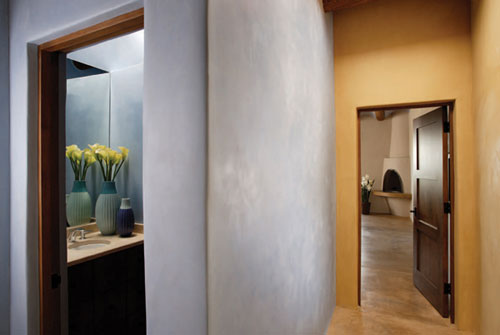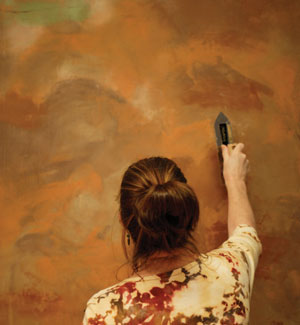The Greening of Color and Texture
Therein lies the rub: Has the reduction of VOCs, which manufacturers once considered essential to the workability of paint, compromised performance in paint consistency and durability?
"Leaders in the paint industry have taken a holistic approach by developing proprietary raw material technology that reduces VOCs in many components that make up the paint formulation," says Revnew, explaining that the first environmental steps in the 1980s came by removing the VOC-containing liquids and adding in more solids, which made paint harder to apply and decreased its workability. "Fast forward twenty years, and the evolution of technology has enabled paint to have a lower VOC content, be easier to apply and high performance."
Manufacturers now offer latex products that rival their oilbased counterparts in performance. "In a marginally prepared surface, oil paint might outperform latex," says Revnew. "But with proper preparation, latex will meet or exceed the performance requirements." Part of the performance factor also means that fewer coats are required and the need for frequent repainting is eliminated, significantly reducing waste and harmful emissions. Proper preparation includes having a clean, dry and dull surface for the coating to adhere to and removing any surface contaminate or higher gloss or oil paint.
Manufacturers' claims for the effectiveness of lower VOC paints is catching a bid in prominent U.S. Green Building Council's Leadership in Energy and Environmental Design (LEED)-certified projects like the Gold-rated Hearst Corporation headquarters, a 46-story tower of glass and steel in midtown Manhattan. Designed by London-based Foster and Partners in conjunction with Gensler Architectural Design and Planning, the tower is all about high performance and low emission. "One of the simplest things you can do to make a building green is to pick paints that have low VOCs," says Brian Schwagerl, vice president of real estate and facilities worldwide for the Hearst Corporation. Most of the interior space of the Hearst Tower was painted with an interior latex paint, which offers zero VOCs and is a low-odor, silica-free coating with antimicrobial properties to resist mildew. Choosing no-VOC paint was a no-brainer, according to Schwagerl. "If you can get quality paint in beautiful colors and not create toxic emissions that your employees are exposed to, why not do it?" he says. "We have the cleanest air of any building in New York City, and the paint is a factor in that."
But, Revnew notes, producing an environmentally responsible paint is not just a question of lower VOCs. "There's a fundamental confusion as to what constitutes green paint. While low- and no-VOC paints are good things, limiting other chemicals and adhering to ASTM performance standards for hiding, washability and scrubability are critical parts of the sustainability story," says Revnew. Some companies designate a product line as "green" if it fulfills certain requirements such as meeting ASTM hiding, washability and scrubability standards, restricting the product's chemical ingredients and having less than 50 grams per liter VOCs.
GreenGuard, Green Seal and Master Painters Institute (MPI) are all third-party, non-profit groups that certify environmentally preferred paints. Green Seal administers performance tests to evaluate coverage and durability - brands that are certified are listed on the group's Web site, greenseal.org. In May 2008, Green Seal updated its GS-11 environmental standards for paint by increasing the number of prohibited chemicals, reducing allowable VOC levels for base paint and colorants, requiring a more accurate test to measure VOCs and including expanded consumer education criteria. GreenGuard and MPI also list their certified products on their websites, www.GreenGuard.org and www.mpi.org.
"The environmental "green" effort is ongoing," says Revnew. "We're constantly conducting research and development, and are on the lookout around the globe for new ingredients and the next generation of raw materials that will take us to zero-VOC and higher performance."
Earthen Plasters - Going Natural
 |
Earthen plasters work in every room in the house. Photo courtesy of American Clay |
Â
One way to get around the issue of VOCs is to use a natural product. Paints can be made from natural raw ingredients from water to plant oils to natural minerals like clay and chalk, milk casein, even bees' wax. When made of natural materials, water-based paints are virtually scentless and oil-based paints may emit a citrusy fragrance or give off an aroma of essential oils. One "paint" option gaining popularity are natural earthen plasters. Less toxic and energy intensive than other wall coverings, earthen plasters are made of natural clays, recycled and reclaimed aggregates, and vibrant natural pigments.
 |
Earthen plaster is applied much like conventional plaster. Photo courtesy of American Clay |
"Natural clay maintains an incredibly dense molecular structure and shape, giving it the capacity to produce a self-generated negative charge upon hydration. Even the simple evaporation of water from clay has the capacity to produce negatively charged particles in the air," says Carol Baumgartel, VP Marketing and Sales at American Clay Enterprises. "This means that when your walls breathe, or hydrate slightly with changes in humidity and slowly dry out, your interior space is being steeped in negative ions." Some people believe that negative ions produce positive biochemical reactions in humans and that they can eliminate static charge, enabling walls to stay cleaner and not attract dust.
Earthen plasters create a durable and easy to maintain surface. Made from a variety of clays, aggregate, mineral pigments and a non-toxic mold inhibitor, earthen plasters feature a binder made from bio-based materials like casein, which is a protein that increases both the stability and strength of the plaster. The binder, which can also take the form of a mud glue, can be mixed into water, the plaster added, and then trowel-applied to a wall much like conventional plaster. For most walls, the recommended application is two thin coats - a base coat 1/32-inch to 1/16-inch thick, followed by a 1/32-inch finish coat and, if desired, a lime-putty top coat to enrich and deepen the colors.
Variations in surface texture are possible: walls can be worked to create a variety of surfaces from rustic to marblesmooth or burnished to a polished sheen without the need for sanding required with acrylic/lime and gypsum finishes. Alternatively, layers of color can be interwoven and then waxed or soaped to approximate Venetian plasters of Mediterranean and Italian villas. Many colors are feasible, though mostly in muted hues. "You have to watch the toxicity of colorants," cautions Baumgartel. "Cadmium, chromium, and cobalt all have toxic properties." Naturebased pigments like ochre and iron oxides are safer and yield a palette encompassing architectural gray to ocean blues to earthy reds and golds. Colorants used in earthen plaster are from dry pigments and, according to manufacturers, do not contain VOCs which are found in liquid pigment dispersions and organic pigments which are based on carbon sources.
"If necessary, the colors can be brightened up with titanium dioxide, a non-toxic whitener," Baumgartel says, noting that other materials from mica chips to shredded straw and recycled colored glass can enhance the surfaces of earthen plaster for a natural, hand-made look. As a natural material, clay has a high light reflectivity quotient. When compressed, the clay particles align in different layers, with each one of the tiny platelets reflecting light differently for a dramatic cumulative effect.
"Humans have logged in thousands of years of living in spaces made of natural building materials," says Baumgartel. "When you consider today's sick building syndrome and increase in the incidence of asthma and other conditions, you have to wonder if we weren't better off back then."









